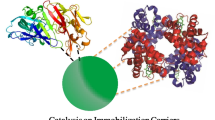Abstract
Invertase was immobilized on chitosan using glutaraldehyde or tris(hydroxymethyl)phosphine as cross-linker. The optimum pH for free and immobilized enzyme was found to be 4.5 and 5.5, respectively. The optimum hydrolysis temperature was 55 °C for both the free and immobilized forms. Km and Vmax values for free invertase, and invertase immobilized on glutaraldehyde- and THP-activated chitosan were 15, 19, and 20 mM, respectively, and 238, 204, and 212 mM min−1, respectively. The THP-immobilized enzyme had the highest pH and thermal stability, higher reusability with 70% retention in activity after 9 batches of reuse and higher storage stability with 90% retention in activity after 12 weeks at 4 °C, pH 4.5. Fermentation of cane molasses by yeast to form ethanol in the presence of free invertase at 30°C, pH 5.0 led to an increase in ethanol production by 3% and the production increased by 10.7% when immobilized invertase was used as catalyst.

Graphical Abstract












Similar content being viewed by others
References
Robinson, P. K. (2015). Enzymes: principles and biotechnological applications. Essays in Biochemistry, 59, 1–41.
Homaei, A. A., Sariri, R., Vianello, F., & Stevanato, R. (2013). Enzyme immobilization: an update. Journal of Chemical Biology, 6, 185–205.
Van de Velde, F., Lourenco, N. D., Pinheiro, H. M., & Bakkerd, M. (2002). Carrageenan: a food-grade and biocompatible support for immobilisation techniques. Advanced Synthesis and Catalysis, 344, 815–835.
Belho, K., Nongpiur, S. R., & Ambasht, P. K. (2014). Immobilization of acid phosphatase (type i) from wheat germ on glutaraldehyde activated chitosan beads: optimization and characterization. Journal of Proteins and Proteomicsics, 5, 177–183.
Oswald, P. R., Evans, R. A., Henderson, W., Daniel, R. M., & Fee, C. J. (1998). Properties of a thermostable β-glucosidase immobilized using tris(hydroxymethyl)phosphine as a highly efective coupling agent. Enzyme and Microbial Technology, 23, 14–19.
Cheng, T. C., Duan, K. J., & Sheu, D. C. (2006). Application of tris(hydroxymethyl)phosphine as a coupling agent for β-galactosidase immobilized on chitosan to produce galactooligosaccharides. Journal of Chemical Technology and Biotechnology, 81, 233–236.
Kulshrestha, S., Tyagi, P., Sindhi, V., & Yadavilli, K. S. (2013). Invertase and its applications-a brief review. Journal of Pharmacy Research, 7, 792–797.
Kotwal, S. M., & Shankar, V. (2009). Immobilized invertase. Biotechnology Advances, 27(4), 311–322.
Rastogi, M., & Shrivastava, S. (2018). Current methodologies and advances in bio-ethanol production. Journal of Biotechnology and Bioresearch, 1.
Robak, K., & Balcerek, M. (2018). Review of second generation bioethanol production from residual biomass. Food Technology and Biotechnology, 56(2), 174–187.
Vohra, M., Manwar, J., Manmode, R., Padgilwar, S., & Patil, S. (2014). Bioethanol production: feedstock and current technologies. Journal of Environmental Chemical Engineering, 2, 573–584.
Rastogi, M., & Shrivastava, S. (2017). Recent advances in second generation bioethanol production: an insight to pretreatment, saccharification and fermentation processes. Renewable and Sustainable Energy Reviews, 80, 330–340.
Lowry, O. H., Rosebrough, N. J., Farr, A. L., & Randall, R. J. (1951). Protein measurement with the Folin phenol reagent. The Journal of Biological Chemistry, 193, 265–275.
Mohamad, N. R., Marzuki, N. H., Buang, N. A., Huyop, F., & Wahab, R. A. (2015). An overview of technologies for immobilization of enzymes and surface analysis techniques for immobilized enzymes. Biotechnology and Biotechnological Equipment, 29(2), 205–220.
Park, Y. K., & Sato, H. H. (1982). Fungal invertase as an aid for fermentation of cane molasses into ethanol. Applied and Environmental Microbiology, 44(4), 988–989.
Rorrer, G. L., Hsien, T. Y., & Way, J. D. (1993). Synthesis of porous magnetic chitosan beads for removal of cadmium ion from wastewater. Industrial and Engineering Chemistry Research, 32, 2170–2178.
Busto, M. D., García-Tramontin, K. E., Ortega, N., & Perez-Mateos, M. (2006). Preparation and properties of an immobilized pectinlyase for the treatment of fruit juices. Bioresource Technology, 97(13), 1477–1483.
Li, S., Hu, J., & Liu, B. (2004). Use of chemically modified PMMA microspheres for enzyme immobilization. Biosystems., 77(1-3), 25–32.
Goldstein, L. (1976). Kinetic behavior of immobilized enzyme systems. Methods in Enzymology, 44, 397–443.
Reddy, K. R. C., & Kayastha, A. M. (2006). Improved stability of urease upon coupling to alkylamine and arylamine glass and its analytical use. Journal of Molecular Catalysis B: Enzymatic, 38, 104–112.
Mahmood, W. A. (2006). Hydrolysis of Sucrose by Immobilized Saccharomyces cerevisiae Invertase. Mesopotamia Journal of Agriculture, 38, 2–11.
Gottlieb, H. E., Kotlyar, V., & Nudelman, A. (1997). NMR chemical shifts of common laboratory solvents as trace impurities. Journal of Organometallic Chemistry, 62, 7512–7515.
Demir, A. (2012). NMR-the basic principles and its use in studies of water/ethanol/mixture. Bachelor Degree Project in Chemistry. Umea: Umea University.
Funding
This research was financially supported by the University Grant Commission (Government of India).
Author information
Authors and Affiliations
Corresponding author
Ethics declarations
Conflict of Interest
The authors declare that they have no conflict of interest.
Additional information
Publisher’s Note
Springer Nature remains neutral with regard to jurisdictional claims in published maps and institutional affiliations.
Highlights
• Invertase from Saccharomyces cerevisiae was immobilized on chitosan.
• Glutaraldehyde and tris(hydroxymethyl)phosphine were compared as cross-linking agents.
• Immobilization using THP as cross-linker increased pH and thermal stability of invertase.
• Invertase immobilized with THP cross-linker was used for bioethanol production from cane molasses.
Rights and permissions
About this article
Cite this article
Malhotra, I., Basir, S.F. Application of Invertase Immobilized on Chitosan Using Glutaraldehyde or Tris(Hydroxymethyl)Phosphine as Cross-Linking Agent to Produce Bioethanol. Appl Biochem Biotechnol 191, 838–851 (2020). https://doi.org/10.1007/s12010-019-03162-3
Received:
Accepted:
Published:
Issue Date:
DOI: https://doi.org/10.1007/s12010-019-03162-3




